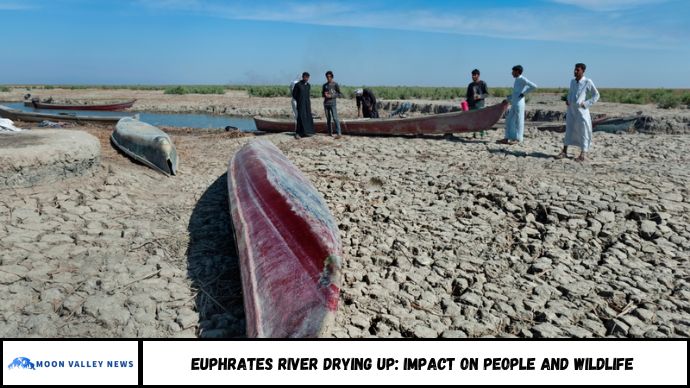The Euphrates River is drying up, and the consequences could be catastrophic. This article explores the causes, impact on humans and wildlife, and the urgent need for action as one of the Middle East’s most important rivers faces a dire future.
The Euphrates River has played a pivotal role in human history. Together with the Tigris, it forms the Fertile Crescent—often called the cradle of civilization. Along its banks, ancient societies like the Sumerians and Mesopotamians developed some of the world’s first agricultural systems and cities. The river even holds religious significance, mentioned in the Bible as one of the four rivers flowing from the Garden of Eden.
Today, however, this once life-giving river faces a growing threat. Climate change, dam construction, and overuse are rapidly depleting its flow—raising tensions and fueling instability in a region already fraught with geopolitical conflict.
Why Is the Euphrates River Drying Up?
Once a lifeline for civilizations, the Euphrates River now faces a dangerous decline in water levels. Stretching over 1,700 miles (2,800 km) from Turkey through Syria and Iraq, this river has supported human settlements for more than 6,000 years. But today, climate change, upstream damming, and mismanagement are threatening its survival.
In this article, we’ll explore:
- The major causes of the river’s drying
- The human and environmental consequences
- Why this crisis matters globally—not just regionally
Causes of the Euphrates River Crisis
1. Climate Change and Prolonged Droughts
The Middle East is warming twice as fast as the global average. Rainfall across the region has declined drastically, leading to longer and more severe droughts.
- According to the World Bank, water availability in the Middle East could fall by 50% by 2050.
- Reduced snowmelt from the Taurus Mountains in Turkey—the river’s source—is also contributing to falling water levels.
2. Upstream Dams
Both Turkey and Iran have built large-scale dams that restrict the flow of water downstream into Syria and Iraq.
- The Atatürk Dam in Turkey is one of the largest in the world and significantly limits downstream flow.
- These projects, while helpful for local irrigation and hydroelectricity, come at the cost of drying out land and ecosystems further south.
3. Poor Water Management
Decades of inefficient irrigation, water-intensive agriculture, and unregulated groundwater extraction have strained an already fragile system.
- In Iraq, 60% of irrigated lands rely on Euphrates water.
- Outdated irrigation methods waste a significant portion of available water.
Human Consequences of a Dying Euphrates
1. Water Scarcity for Millions
Over 60 million people in Iraq, Syria, and Turkey depend directly on the Euphrates for drinking water, agriculture, and sanitation.
- Rural communities in Syria and Iraq are experiencing mass displacement due to failed crops and lack of clean water.
- Major cities like Raqqa and Deir ez-Zor face increasing water shortages.
2. Food Insecurity
The Euphrates irrigates fertile farmland in the Fertile Crescent. As it dries, agriculture collapses.
- Wheat and barley production in Syria has plummeted.
- Rising food prices and economic instability are directly tied to water shortages.
3. Social and Political Tension
Water scarcity exacerbates existing political conflicts in the region.
- Competition over limited resources has intensified tensions between Turkey, Syria, and Iraq.
- Within countries, the lack of water is fueling migration, poverty, and civil unrest.
Wildlife and Ecosystem Impacts
The Euphrates supports diverse ecosystems and acts as a critical water source for wildlife, particularly in arid zones.
Species and Habitats at Risk:
- Bird species in Iraq’s marshlands are losing nesting grounds.
- Fish populations are declining rapidly due to reduced flow and rising water salinity.
- The Mesopotamian Marshes, once listed as a UNESCO World Heritage site, are vanishing.
In 2023, a report from the UN Environment Programme highlighted that over 70% of wetland habitats along the Euphrates had dried up in just two decades.
Why the World Should Care
The drying of the Euphrates is not just a local crisis—it’s a global warning sign.
- It underscores how climate change, geopolitics, and mismanagement intersect.
- As water scarcity increases worldwide, the Euphrates crisis could be a blueprint for future global water conflicts.
- Preserving transboundary rivers like the Euphrates requires regional cooperation and international attention.
FAQs
1. Why is the Euphrates River drying up?
Due to climate change, damming, and poor water management practices across Turkey, Syria, and Iraq.
2. Who depends on the Euphrates River?
Over 60 million people across the Middle East rely on it for drinking water, agriculture, and energy.
3. How is wildlife affected?
Wetlands are shrinking, bird habitats are disappearing, and fish populations are collapsing.
4. Can the Euphrates River be saved?
Yes, with international cooperation, sustainable water policies, and climate action, recovery is possible.
5. Are there health risks associated with the river drying?
Yes. Contaminated water and poor sanitation are leading to increased disease risk in affected areas.
6. Is this crisis related to global climate change?
Absolutely. Rising temperatures and declining rainfall are key contributors to the river’s drying.
Conclusion
The drying of the Euphrates River is a slow-moving disaster with fast-accelerating consequences. It threatens millions of lives, entire ecosystems, and political stability in a region already facing immense challenges.
But this is not an irreversible fate. With regional cooperation, modernized water systems, and stronger climate policy, there is still hope for the Euphrates and those who depend on it.







